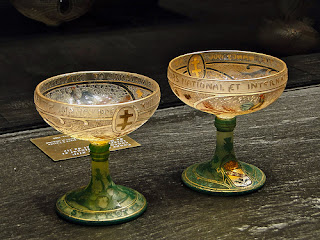A Crémant de Bourgogne, Burgundy.
Photograph courtesy of http://www.kvins.com
The sparkling wines outside of the Champagne region.
Crémants are a group of sparkling wines that come from outside the area of Champagne. They are made in the same manner as Champagne. Nevertheless, the grapes used for these wines are mostly different from those used for Champagne. To confuse us a little more these wines are bottled in Champagne type bottles. They are produced in at least 12 of France’s wine-producing regions. Apart from knowledgeable Champagne mavens, crémants represent, for the rest of us, the best value in France’s exceptional sparkling wines.
A crémant is made by the method Champenoise, the Champagne method, now officially called, the method traditional. The name of the production method was changed, for sparkling wines from outside Champagne, by Europe’s bureaucrats. The name changed but the method of producing these sparkling wines did not. The legal change in the name used in the production process only tries to limit the competition by removing the Champagne connection.
With crémants' generally high quality and low prices, there is no need to save a crémant for a particular occasion; they are good enough and inexpensive enough to be considered whenever any white or rosé wine may be the wine of choice. Every crémant production area has its own alcohol level that varies from 10% to 13%, the percentage is on the label.
A Crémant Rosé.
Langlois Cremant de Loire Brut
www.flickr.com/photos/farehamwine/16519044737/
If you have chosen a half-day to wander around a French town with no set timetable consider my suggestion for lunch. Buy reasonable amounts of one or two or three cheeses, that's about 20 grams per person. Remember to buy just enough for lunch as I speak from experience. Where French cheeses are concerned, I admit to always buying far too much. Purchase a portion or two of pâté, and then buy a cold crémant; I suggest a crémant brut, that is a mildly dry wine. All should be available in the nearest supermarket, and for a crémant, like Champagne, no corkscrew is required. All that is needed is a knife for your cheese and pate, a couple of plastic plates, plastic forks, and glasses along with napkins or paper towels. If you are planning ahead then buy the crémant the night before. Ask your hotel to put your bottle of crémant in their kitchen’s refrigerator overnight. In the morning, when you set out, buy a fresh baguette along with the cheeses, pate, and plates, etc. Begin your walk around the town. Hopefully, it will be a beautiful day. When you are ready for lunch, find a park or a suitable place to sit down. Enjoy the cheese, pâté, and baguette while sipping the wine. Sit, sip, enjoy, and watch the world go by; it has much to recommend it.
Antique Champagne or Crémant coupes 1906.
(A champagne glass is never called a verre).
www.flickr.com/photos/alexprevot/6159028343/
Buying a Crémant in France.
You can find excellent French wines at home, and that will include crémants. However, a French supermarket or wine shop will have crémants at prices far cheaper than a wine shop at home. Supermarkets are much cheaper than the duty-free; that is if crémants are available in the duty-free. Buy a non-vintage crémant, that’s a cuvée; the word cuvée will be on the bottle’s label. Outside of a restaurant, there is no need to pay more than € 12.00 for a bottle of crémant, and most will be much less. Crémants are truly the best value in French sparkling wines.
Choosing the sweetness level in a crémant.
The sweetness standards of Champagne, crémants and other sparkling wines are NOT the same as those used for still wines. Do not buy a bottle of any sparkling wine without using those different rules. Remember in the world of crémants, like the world of Champagne, ordinary still wine sweetness classifications do not apply.
Copy this list on your mobile phone and take it with you when buying a cremant.
Ultra Brut – This is a very dry Champagne, crémant or other sparkling wine. This is nearly the nearest a sparkling wine will get to a pleasant bone dry. Personally, I think ultra-brut, along with brut, shows the best in French sparkling wines. The same is true with similar sparkling wines from outside France like the Italian Prosecco.
Brut – A dry, excellent, Champagne or crémant. Not as dry as an ultra brut, but still a delightful sparkling wine with under 1.5% sugar. Brut wines are the most popular level of sweetness.
Sec - Dry in a white wine. However, in a sparkling wine, this is slightly sweet. Do not let this confuse you; if you want a slightly sweet Champagne or crémant then order it sec, dry! That may seem odd, but sparkling wines work by different rules to still wines.
Demi-sec or Semi-sec – For regular still wines demi-sec translates as semi-dry, but again this is not true for sparkling wines. In a Champagne or a crémant, a demi-sec or semi-sec will be a very very sweet Champagne or crémant! These wines will be as sweet or sweeter than most dessert wines.
Doux- Sweet. In reality, this will be a sickly sweet dessert Champagne or crémant; the sugar will be dripping down your throat!
Á votre santé! - Your health – Cheers!
These glasses are Champagne or crémant flutes.
(A
champagne glass is never called a verre).
www.flickr.com/photos/pf1elcc/2828930343/
Connected Posts:
Behind the French Menu’s links include hundreds of words, names, and phrases that are seen on French menus. There are over 400 articles that include over 2,500 French dishes, food products, wines and more. All with English translations and explanations. Add the word, words or phrase that you are searching for to the words "Behind the French Menu" and search with Google or Bing.
Behind the French Menu
by
Bryan G. Newman
behindthefrenchmenu@gmail.com
Copyright 2010, 2011, 2012, 2015, 2016, 2019.












